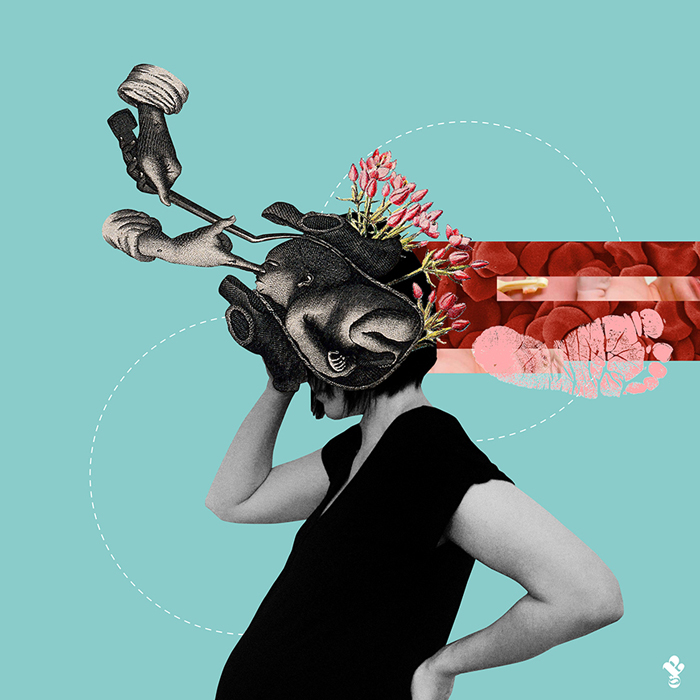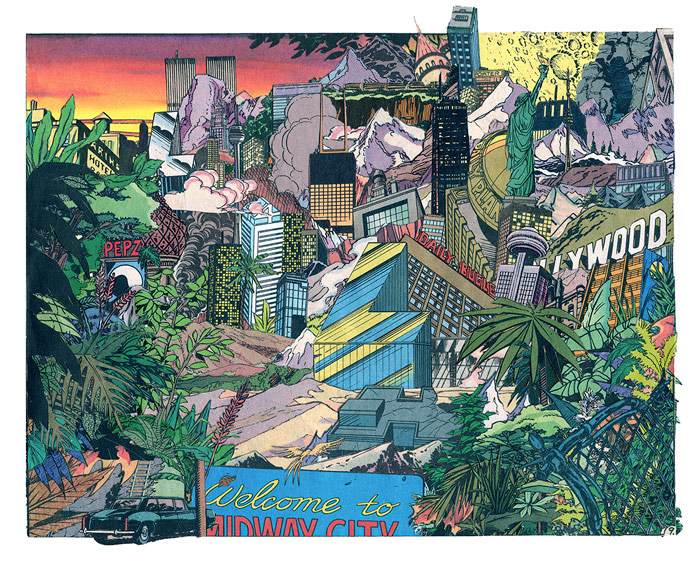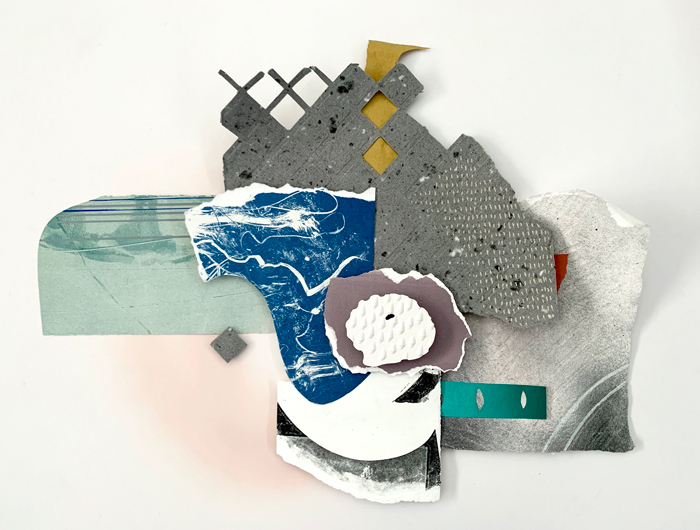
8.3″x8.3″; digital collage; 2018-2022. Courtesy of the artist.
COLLAGE SYMPOSIUM AT KOLAJ FEST NEW ORLEANS 2023
Making Sense, Making Meaning
with Ana Reguera Hernández, Andrew Rice, J Dylan, & Lisa Wicka
LEARN MORE | REGISTER FOR KOLAJ FEST NEW ORLEANS
Kolaj Fest New Orleans is a multi-day festival and symposium about contemporary collage and its role in art, culture, and society, 7-11 June 2023. Visit the website to learn more, see an overview of the program, and register to attend.
Max Pensky wrote about how the great philosopher and culture critic Walter Benjamin thought about Surrealism: “While the Surrealists surely desired a political effect from their projects, the technique of montage was surely one that made most sense when seen as the logical outcome of an institutionally structured history of painting: rejecting the model of the solitary creative genius, the method stuck together otherwise useless or discarded found objects–paper scraps, portions of painted canvas, newspaper, ticket stubs, cigarette butts, buttons–in a construction whose power to disorient and to shock lay to a large degree in the defamiliarization effect of seeing otherwise meaningless material objects suddenly removed from the context that determines their meaninglessness. To be sure, the shocking aspect of Surrealist montages presupposes the capacity of the audience to reflect upon the very activity of aesthetic reception and appreciation.” Montages got their meaning from the work the viewer did to make sense of them but for all their “quite extravagant notions of ‘objective chance,’ automatic writing, intoxication, dream-states, and so forth” they need the artist to show them the way. “It remains clear,” wrote Pensky, “that the Surrealist montage, like virtually all its cognate artistic products of the aesthetic and literary avant-garde, requires rather a lot of authorial intention.” Nearly a century later, collage artists continue to use Surrealist approaches to make images. Unlike a century ago, they do so in a world where theories of material culture, marxism, and post-modernism are part of mainstream thought. In the panel, “Making Sense, Making Meaning”, four contemporary collage artists will present their work and lead a conversation about how collage helps us make sense of the world and how meaning is made.
Ana Reguera Hernández (aka Madame Milton) mixes “pop icons and images from fashion magazines of any era with consumer objects extracted from image banks and catalogs, trying to represent our reality (changing, nostalgic, self- referential and contradictory) with women as protagonists.” Reguera Hernández will present “Un montón de ilustraciones que me habría gustado no tener que hacer” (A lot of illustrations I wished I never had to do) that was made for Pikara Magazine, a feminist magazine in Spain, and exhibited in MCC in Mieres, Spain during a week long event that included conferences, art exhibits and concerts against gender violence. The Oviedo-based artist writes, “Collage is, nowadays, a perfect technique to represent our reality: fragmented, heterodox, nostalgic, self-referential, a bit surreal, humorous, tragic and a little incoherent. Also, it allows me to work at different levels and include textures, materials and multiple details that amplify and diversify the sense of the main image in different directions, sometimes convergent and others contradictory.”

8″x10″; collage; 2021. Courtesy of the artist.
“Our contemporary post-post modern culture is marked by this sense of inertia and of nostalgic montaging, taking culture from past eras and presenting it as new.” Salt Lake City, Utah-based Andrew Rice is “drawn into the youthful optimism the comic book imagery holds. This idea of the future we were promised. A future that never came.” The artist draws on the late culture theorist Mark Fisher’s (aka k-punk) work on Capitalist Realism and Jacques Derrida’s concept of hauntology, the idea that contemporary culture is “haunted” by a lost future of modernity. He will speak about “how remixing the ephemera of the past as a means to help us to make sense of the endless repetition and re-circulation of the already familiar. In a neoliberal globalized world, our entire culture is a mash-up of what came before and collage is the medium to best reflect that.”

18″x24″; handmade cast paper, monotype, cyanotype, plaster, spray paint and collage; 2023. Courtesy of the artist.
Lisa Wicka is a printmaker who collages her own made material to “question the solidity and accuracy of things we hold true.” She writes, “My work is a surface where this dialogue becomes visible explorations of my surroundings and my identity, a surrogate self with limitless possibilities.” Her “Gather” series “reflects on parts of ourselves that are difficult to hang onto. What we see as important can wax and wane, as parts of our lives are forgotten or taken away out of our control. This explores the moments I wished I would have paid more attention to, times I was the happiest, and memories with loved ones that are no longer here. By loosely referencing wall shrines, mausoleum alters, and reliquaries, I attempt to hang onto these parts of myself a little longer…By focusing on these memories, I can remember, grieve, and try to come to terms with that which is out of my control.”

10″x15″; pigment inkjet print; 2022. Courtesy of the artist.
J Dylan uses “photographs as fragments of disassembled structures, creating a metaphor for the absence of predetermined architecture for human life.” They will speak about Walter Benjamin’s ideas about fragmentation, and present their piece titled (re)Bild. J will discuss collaging their own photographs, highlighting the process of working with images of their own body. The New York City-based artist writes, “I dismantle structures like my body to articulate malleability. I (re)design my body in the same way that I (re)design ‘natural’ structures like gender identity and sexuality. I continue to think about (re)forming the frameworks that I was born into as uncertainty emanates with the right to make decisions about one’s own body rapidly shifting, as I witness the threats of antisemitic and anti-queer hate increase, and as so many other institutions collapse and unravel.”
“Making Sense, Making Meaning” is an opportunity for us to consider how collage functions in the world and the mechanics of how collage resonates with ourselves as artists and with viewers.
About Kolaj Fest New Orleans
Kolaj Fest New Orleans is a multi-day festival and symposium about contemporary collage and its role in art, culture, and society, 7-11 June 2023. Visit the website to learn more, see an overview of the program, and register to attend. Kolaj Fest New Orleans would not be possible without the support of the members of Kolaj Institute’s Golden Glue and Silver Scissors Societies, Kolaj Magazine and Kasini House. WEBSITE
